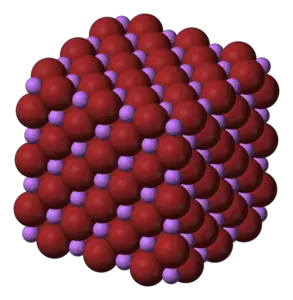Lithium Bromide Formula
Lithium Bromide
We also know lithium bromide by the name lithium monobromide or bromolithium formula. Basically, it is a lithium salt in which the counterion is bromide. Furthermore, the anhydrous salt of lithium bromide forms cubic crystals which are similar to common salt (Sodium chloride NaCl). Basically, it is a bromide salt as well as a lithium salt. The compound is extremely hygroscopic, which makes it suitable for desiccant in the air conditioning systems. Learn Lithium Bromide Formula here.
Lithium Bromide Formula and structure
The chemical formula of lithium bromide is LiBr. It has a molecular weight of 86.845 g/mol. During the formation of Lithium Bromide, the lithium-ion that has a positive charge

Production of Lithium Bromide
We can prepare lithium bromide by the reaction of lithium carbonate with hydrobromic acid. Unlike the other alkali metal bromides salt from several crystalline hydrates.
Besides, lithium hydroxide reacts with hydrobromic acid (aqueous solution of hydrogen bromide) from lithium bromide. The reaction is as follows:
Physical properties of lithium bromide
It is a white, crystalline, deliquescent solid. The density of lithium bromide is
However, all these hydrates have distinct melting points. In addition, the concentrated aqueous solutions of lithium bromide can dissolve significant quantities of polar organic substances such as cellulose. In polar organic solvents such as alcohol lithium bromide is soluble just like lithium chloride.
Chemical properties of lithium bromide
It has a white cubic crystal, hygroscopic structure. Its refractive index is 1.784. It is highly soluble in water and much greatly soluble in hot water. Along with that, it is also soluble in ethanol, methanol, and ether. It is slightly soluble in pyridine, vapor pressure of aqueous solutions at 52 and 68% concentration at
Uses of lithium bromide
We use lithium bromide in air-conditioning systems as a desiccant. Along with water, we use lithium bromide as salt for absorbing chilling. In organic synthesis, it is useful as a reagent. For instance, it reversibly forms adducts with some pharmaceuticals.
Moreover, in the medical field, they use it as a sedative at the beginning of the 1990s, then it fell into disapproval in the 1940s when some patients died after using it as a substitute for salt. We can treat it as bipolar disorder just like lithium carbonate and lithium chloride.
Safety and health hazards of lithium bromide
Lithium bromide is somewhat corrosive and psychoactive. It generates heat quickly when dissolved in water due to the negative enthalpy of the solution. It is acutely toxic if swallowed, and when it comes in contact with the skin causes irritation. Furthermore, it can cause allergic reactions and serious eye irritation in some people.
In addition, anhydrous lithium bromide is extremely hygroscopic and contact with a tissue can produce a dehydrating action that may result in localized burns. If ingested into the body then it may cause gastrointestinal irritation with vomiting, diarrhea, and nausea.
Solved Example for You
Question: Mention a method to prepare lithium bromide?
Solution: We can prepare lithium bromide by the reaction of lithium carbonate with an aqueous solution of hydrobromic acid: